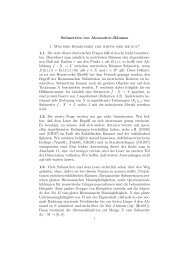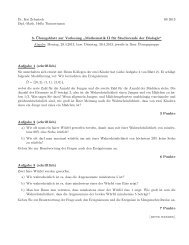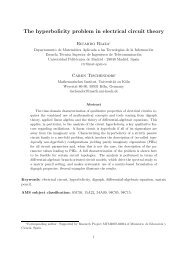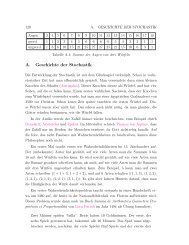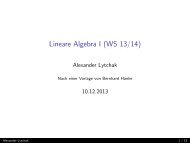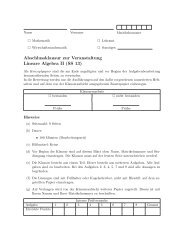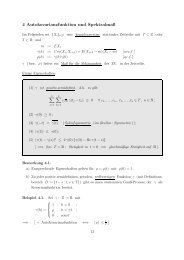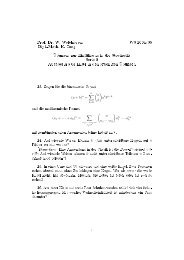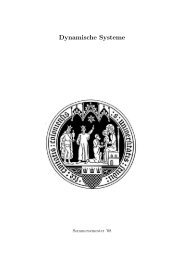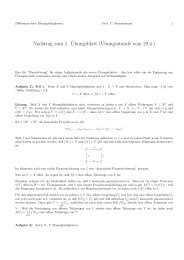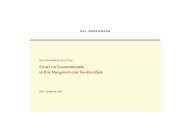Inhaltsverzeichnis - Mathematisches Institut der Universität zu Köln
Inhaltsverzeichnis - Mathematisches Institut der Universität zu Köln
Inhaltsverzeichnis - Mathematisches Institut der Universität zu Köln
Create successful ePaper yourself
Turn your PDF publications into a flip-book with our unique Google optimized e-Paper software.
DMV Tagung 2011 - <strong>Köln</strong>, 19. - 22. September<br />
Frauke Liers, Christoph Buchheim, Laura Sanità<br />
<strong>Universität</strong> <strong>zu</strong> <strong>Köln</strong>, Technische <strong>Universität</strong> Dortmund, École Polytechnique Fédérale de Lausanne<br />
An exact Algorithm for Robust Network Design with a Discrete Set of Traffic Matrices<br />
Mo<strong>der</strong>n life heavily relies on communication networks that operate efficiently. A crucial issue for the design<br />
of communication networks is robustness with respect to traffic fluctuations, since they often lead to<br />
congestion and traffic bottlenecks. In this paper, we address an NP-hard single commodity robust network<br />
design problem, where the traffic demands change over time. For k different times of the day, we are given<br />
for each node the amount of single-commodity flow it wants to send or to receive. The task is to determine<br />
the minimum-cost edge capacities such that the flow can be routed integrally through the net at all times.<br />
We present an exact branch-and-cut algorithm, based on a decomposition into biconnected network components,<br />
a clever primal heuristic for generating feasible solutions from the linear-programming relaxation,<br />
and a general cutting-plane separation routine that is based on projection and lifting. By presenting extensive<br />
experimental results on realistic instances from the literature, we show that a suitable combination of<br />
these algorithmic components can solve most of these instances to optimality. Furthermore, cutting-plane<br />
separation consi<strong>der</strong>ably improves the algorithmic performance.<br />
Literatur<br />
Buchheim, Liers, Sanità (2011). In J. Pahl, T. Reiners and S. Voß (Eds.): INOC 2011, LNCS 6701, pp.<br />
7-17, 2011.<br />
Gregor Pardella, Frauke Liers<br />
<strong>Universität</strong> <strong>zu</strong> <strong>Köln</strong><br />
Maximum Flows in Grid Graphs<br />
Maximum-flow problems occur in a wide range of applications. Although already well-studied, they are<br />
still an area of active research. The fastest available implementations for determining maximum flows in<br />
graphs are either based on augmenting-path or on push-relabel algorithms. In this talk, we present two<br />
ingredients that, appropriately used, can consi<strong>der</strong>ably speed up these methods. On the one hand, we<br />
present flow-conserving conditions un<strong>der</strong> which subgraphs can be contracted to a single vertex. These<br />
rules are in the same spirit as presented by Padberg and Rinaldi (Math. Programming (47), 1990) for<br />
the minimum cut problem in graphs. On the other hand, we propose a two-step max-flow algorithm for<br />
solving the problem on instances coming from physics and computer vision. In the two-step algorithm<br />
flow is first sent along augmenting paths of restricted lengths only. Starting from this flow, the problem is<br />
then solved to optimality using some known max-flow methods. By extensive experiments on instances<br />
coming from applications in theoretical physics and in computer vision and on random instances, we<br />
show that a suitable combination of the proposed techniques speeds up traditionally used methods.<br />
Literatur<br />
Y. Boykov and V. Kolmogorov (2004). An Experimental Comparison of Min-Cut/Max-Flow Algorithms for<br />
Energy Minimization in Vision. IEEE Transactions on Pattern Analysis and Machine Intelligence, 26(9),<br />
1124 – 1137.<br />
A. V. Goldberg and R. E. Tarjan (1988). A New Approach to the Maximum-Flow Problem. Journal of the<br />
Association for Computing Machinery, 35(4), 921 – 940.<br />
M. Padberg and G. Rinaldi (1990). An Efficient Algorithm for the Minimum Capacity Cut Problem. Mathematical<br />
Programming A, 47(1), 19 – 36.<br />
69




